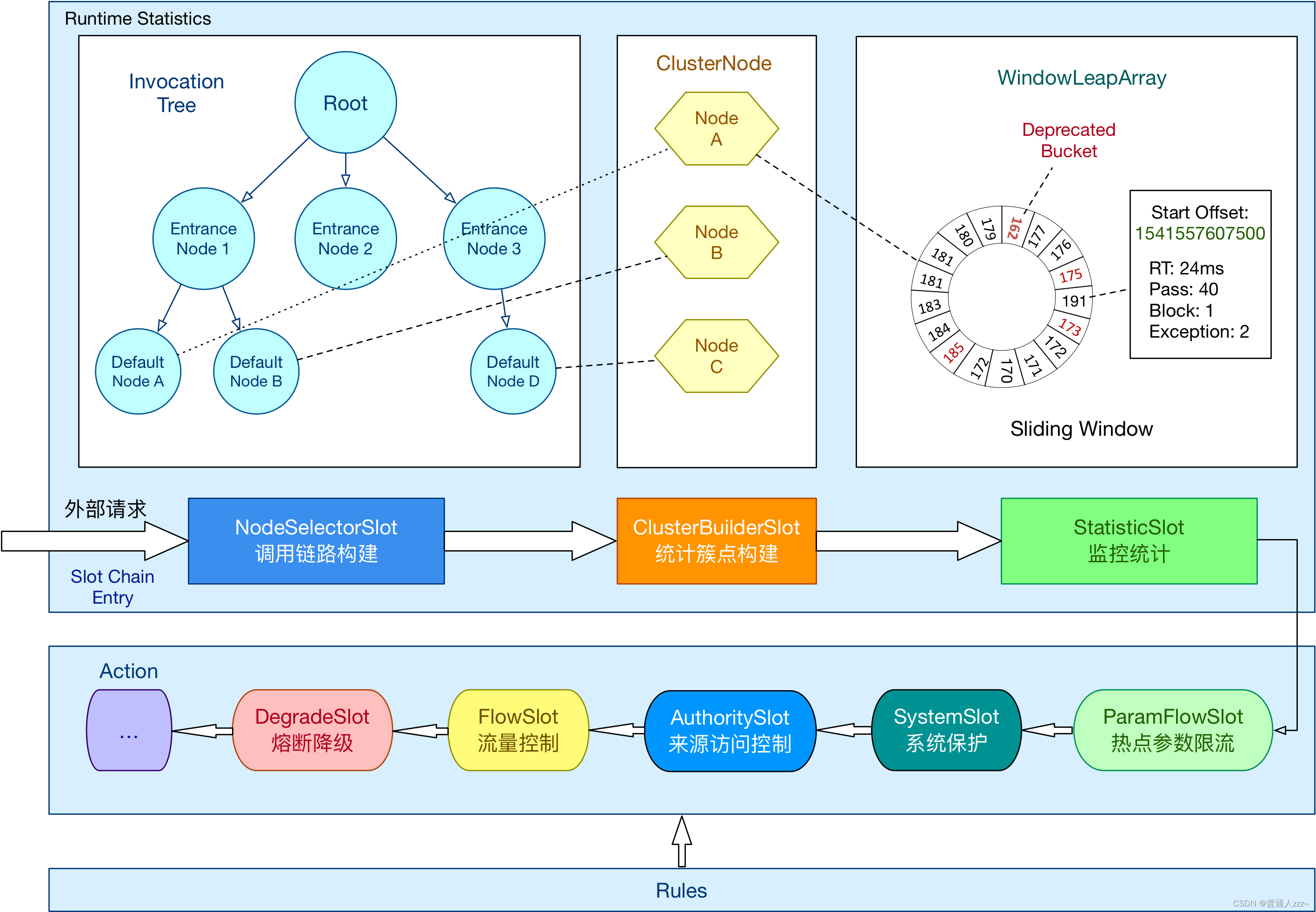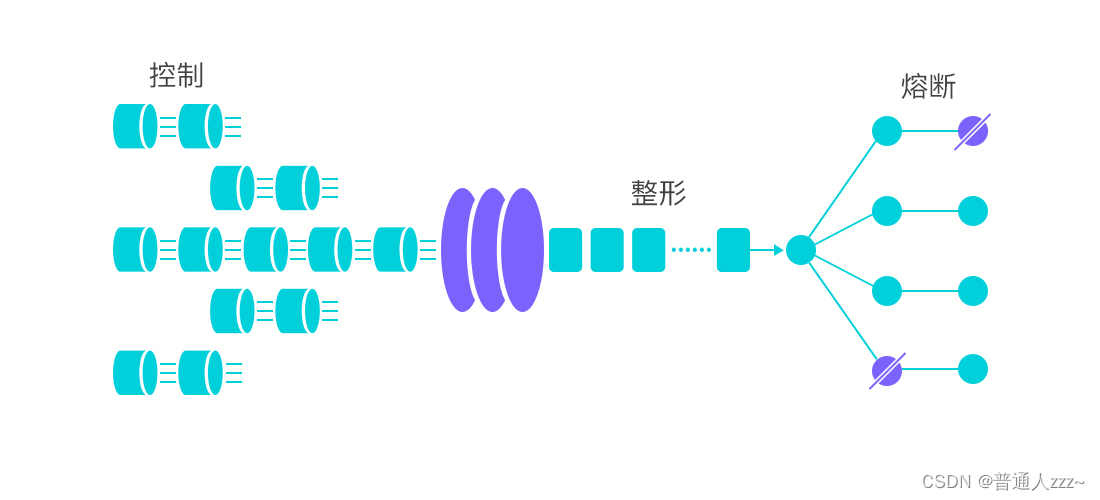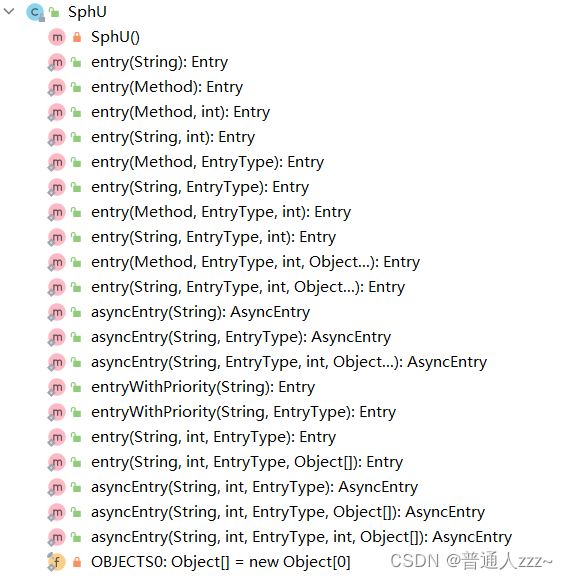Sentinel - 工作流程及原理解析
文章系列
【一、Alibaba Sentinel 基操】
【二、Alibaba Sentinel - 集群流量控制】
【三、Alibaba Sentinel - 工作流程及原理解析】
【四、Alibaba Sentinel - Slot chain解析】
【五、Alibaba Sentinel - 滑动窗口】
随着微服务的流行,服务和服务之间的稳定性变得越来越重要。Sentinel 是面向分布式、多语言异构化服务架构的流量治理组件,主要以流量为切入点,从流量路由、流量控制、流量整形、熔断降级、系统自适应过载保护、热点流量防护等多个维度来帮助开发者保障微服务的稳定性。
一、Sentinel 基本概念
资源(Resource)
资源是 Sentinel 的关键概念。它可以是 Java 应用程序中的任何内容,例如,由应用程序提供的服务,或由应用程序调用的其它应用提供的服务,甚至可以是一段代码。
规则(Rule)
围绕资源的实时状态设定的规则,可以包括流量控制规则、熔断降级规则以及系统保护规则。所有规则可以动态实时调整。Sentinel 目前存在五种规则种类:1. 流量控制规则(FlowRule);2. 熔断降级规则 (DegradeRule);3. 系统保护规则(SystemRule);4. 来源访问控制规则(AuthorityRule);5. 热点参数规则(ParamFlowRule);
插槽(Slot Chain)
Sentinel的工作流程是围绕着一个个插槽所组成的插槽链来展开的。每个Slot都有自己的功能,通过一定的编排顺序,来达到最终的限流降级的目的。
Sentinel 内置插槽有NodeSelectorSlot、ClusterBuilderSlot、StatisticsSlot、ParamFlowSlot、SystemSlot、AuthoritySlot、FlowSlot、DegradeSlot。当然也支持自定义插槽,Sentinel 将 com.alibaba.csp.sentinel.slotchain.ProcessorSlot 作为 SPI 接口进行扩展(1.7.2 版本以前 com.alibaba.csp.sentinel.slotchain.SlotChainBuilder 作为 SPI),使得 Slot Chain 具备了扩展的能力。
调用链路上下文(Context)
Context贯穿一次调用链路中的所有 Entry。Context 维护着当前调用链的元数据:入口节点、本次调用链路节点、调用来源等信息,通过 ThreadLocal传递。
Entry
Entry 是指 Sentinel 中请求是否通过限流的一个凭证。每次执行 SphU.entry() 或 SphO.entry() 都会返回一个 Entry 给调用者。资源调用结束时需要 entry.exit()。Entry 包含了资源名、curNode(当前统计节点)、originNode(来源统计节点)等信息。
节点(Node)
节点。在Sentinel中保存统计数据的对象有4种:1. StatisticNode:统计节点,最为基础的统计节点,包含秒级和分钟级两个滑动窗口结构。2. DefaultNode:链路节点,用于统计调用链路上某个资源的数据,维持树状结构。3. ClusterNode:簇节点,用于统计每个资源全局的数据(不区分调用链路),以及存放该资源的按来源区分的调用数据。4. EntranceNode:入口节点,特殊的链路节点,对应某个 Context 入口的所有调用数据。
二、Sentinel 工作流程
在 Sentinel 里面,所有的资源都对应一个资产名称以及一个 Entry。 Entry 可以通过对主流框架的适配自动创建,也可以通过注解的方式或调用 API 显示创建;每一个 Entry 创建的时候,同时也会创建一系列功能插槽(slot chain),这些插槽有不同的职责,通过责任链方式进行构建,整体框架如下:

这些插槽(slot chain)具有不同职责。
- NodeSelectorSlot:负责收集资源的路径,并将这些资源的调用路径,以树状结构存储起来,用于根据调用路径来限流、降级。
- ClusterBuilderSlot:用于存储资产的统计信息,以及调用者信息,例如,该资源的RT(平均响应时间)、QPS、Thread Count等等,这些信息将用于作为多维度限流、降级的依据。
- StatisticsSlot:用于记录、统计不同维度的 runtime 指标监控信息。
- ParamFlowSlot:用于资源配置热点参数、限流规则以及前面 slot 统计的状态,来进行流量控制。
- SystemSlot:通过系统的状态,例如 load1 等,来控制总的入口流量。
- AuthoritySlot:根据配置的黑白名单和调用来源信息,来做黑白名单控制。
- FlowSlot:用于根据预设的限流规则以及前面 slot 统计的状态,来进行流量控制。
- DegradeSlot:通过统计信息以及预设的规则,来做熔断降级。
自定义插槽(slot chain)
Sentinel 将 com.alibaba.csp.sentinel.slotchain.ProcessorSlot 作为 SPI 接口进行扩展(1.7.2 版本以前 com.alibaba.csp.sentinel.slotchain.SlotChainBuilder 作为 SPI),使得 Slot Chain 具备了扩展的能力。
您可以自行加入自定义的 slot 并编排 slot 间的顺序,从而可以给 Sentinel 添加自定义的功能。

默认处理器插槽的顺序
// NodeSelectorSlot
public static final int ORDER_NODE_SELECTOR_SLOT = -10000;
// ClusterBuilderSlot
public static final int ORDER_CLUSTER_BUILDER_SLOT = -9000;
// LogSlot
public static final int ORDER_LOG_SLOT = -8000;
// StatisticsSlot
public static final int ORDER_STATISTIC_SLOT = -7000;
// AuthoritySlot
public static final int ORDER_AUTHORITY_SLOT = -6000;
// SystemSlot
public static final int ORDER_SYSTEM_SLOT = -5000;
// FlowSlot
public static final int ORDER_FLOW_SLOT = -2000;
// DegradeSlot
public static final int ORDER_DEGRADE_SLOT = -1000;
三、Sentinel 原理解析
使用 Sentinel 来进行资源保护,主要分为几个步骤:
- 定义规则
- 定义资源
- 检验规则是否生效
3.1 定义规则
Sentinel 的所有规则都可以在内存态中动态地查询及修改,修改之后立即生效。同时 Sentinel 也提供相关 API,供您来定制自己的规则策略。
Sentinel 支持以下几种规则:流量控制规则、熔断降级规则、系统保护规则、来源访问控制规则 和 热点参数规则。
下面以流量控制规则为例。
private static void initFlowQpsRule() {
List<FlowRule> rules = new ArrayList<>();
FlowRule rule1 = new FlowRule();
rule1.setResource(resource);
// Set max qps to 20
rule1.setCount(20);
rule1.setGrade(RuleConstant.FLOW_GRADE_QPS);
rule1.setLimitApp("default");
rules.add(rule1);
// 加载 流量控制规则
FlowRuleManager.loadRules(rules);
}
可以看到,在初始化规则的过程中,我们主要是创建了一个 FlowRule 对象,然后通过 FlowRuleManager 的 loadRules(List<FlowRule> rules) 方法加载规则。
FlowRuleManager.loadRules(rules)
public class FlowRuleManager {
// 存放资源规则:一个资源可以拥有多个限流规则
// key -> resource name value -> 去重后的 FlowRule
private static volatile Map<String, List<FlowRule>> flowRules = new HashMap<>();
// 流量规则监听器:动态规则实现,监听规则变化
private static final FlowPropertyListener LISTENER = new FlowPropertyListener();
// 动态规则对象:存储所有FlowRule,当规则存在变更时,通知 FlowRuleManager 中的LISTENER 进行处理
private static SentinelProperty<List<FlowRule>> currentProperty = new DynamicSentinelProperty<List<FlowRule>>();
private static final ScheduledExecutorService SCHEDULER = Executors.newScheduledThreadPool(1,
new NamedThreadFactory("sentinel-metrics-record-task", true));
static {
// 添加 LISTENER 到 DynamicSentinelProperty 中
currentProperty.addListener(LISTENER);
// 开启一个任务:每隔一段时间,统计并保存限流信息到本地磁盘
startMetricTimerListener();
}
/**
* 加载规则
*/
public static void loadRules(List<FlowRule> rules) {
// 更新规则
currentProperty.updateValue(rules);
}
}
1. DynamicSentinelProperty.updateValue(T newValue)
DynamicSentinelProperty 中的 boolean updateValue(T newValue) 用于刷新限流规则。
public class DynamicSentinelProperty<T> implements SentinelProperty<T> {
@Override
public boolean updateValue(T newValue) {
// 判断已有规则是否和当前规则相对
if (isEqual(value, newValue)) {
return false;
}
RecordLog.info("[DynamicSentinelProperty] Config will be updated to: {}", newValue);
// 更新设值
value = newValue;
// 通知listener 规则更新
for (PropertyListener<T> listener : listeners) {
listener.configUpdate(newValue);
}
return true;
}
}
其中主要逻辑就是更新规则,然后通知其中的 Listener 进行配置更新。DynamicSentinelProperty 中的 listener 对象在 FlowRuleManager 中进行设值,所以会调用到 FlowRuleManager 中的 FlowPropertyListener 内部类的方法。
2. FlowPropertyListener
FlowPropertyListener 用于监听 Sentinel 规则的动态变化,完成本地限流规则缓存更新。
public class FlowRuleManager {
// 存放资源规则:一个资源可以拥有多个限流规则
// key -> resource name value -> 去重后的 FlowRule
private static volatile Map<String, List<FlowRule>> flowRules = new HashMap<>();
private static final class FlowPropertyListener implements PropertyListener<List<FlowRule>> {
@Override
public synchronized void configUpdate(List<FlowRule> value) {
/********规则配置更新*********/
Map<String, List<FlowRule>> rules = FlowRuleUtil.buildFlowRuleMap(value);
if (rules != null) {
flowRules = rules;
}
RecordLog.info("[FlowRuleManager] Flow rules received: {}", rules);
}
@Override
public synchronized void configLoad(List<FlowRule> conf) {
/********规则配置加载*********/
Map<String, List<FlowRule>> rules = FlowRuleUtil.buildFlowRuleMap(conf);
if (rules != null) {
flowRules = rules;
}
RecordLog.info("[FlowRuleManager] Flow rules loaded: {}", rules);
}
}
}
其中 configUpdate(List<FlowRule> value) 以及 configLoad(List<FlowRule> conf) 方法都调用了 FlowRuleUtil.buildFlowRuleMap(List<FlowRule> list)。
注意: configLoad(List<FlowRule> conf) 以及 FlowRuleUtil.buildFlowRuleMap(List<FlowRule> list) 方法都在方法前面添加了 synchronized 关键字,所以内部所有的操作都是 线程安全 的。
3. FlowRuleUtil.buildFlowRuleMap(List list)
FlowRuleUtil.buildFlowRuleMap(List<FlowRule> list) 用于从 List<FlowRule> list 构建限流规则映射,按资源名称(resource name)分组。
public final class FlowRuleUtil {
public static Map<String, List<FlowRule>> buildFlowRuleMap(List<FlowRule> list) {
return buildFlowRuleMap(list, null);
}
public static Map<String, List<FlowRule>> buildFlowRuleMap(List<FlowRule> list, Predicate<FlowRule> filter) {
return buildFlowRuleMap(list, filter, true);
}
public static Map<String, List<FlowRule>> buildFlowRuleMap(List<FlowRule> list, Predicate<FlowRule> filter,
boolean shouldSort) {
return buildFlowRuleMap(list, extractResource, filter, shouldSort);
}
/**
* 构建限流规则映射
* @param list:限流规则list
* @param Function<FlowRule, K> groupFunction:一个java 8 中的Function,用于获取规则名称resourceName
* private static final Function<FlowRule, String> extractResource = new Function<FlowRule, String>() {
* @Override
* public String apply(FlowRule rule) {
* return rule.getResource();
* }
* };
* @param filter:一个java 8 中的Predicate,用于过滤某些规则
* @param shouldSort:是否排序
*
* @return Map<K, List<FlowRule>> 其中key 为资产名称,value为当前资产的所有FlowRule(通过Set去重后的值)
*/
public static <K> Map<K, List<FlowRule>> buildFlowRuleMap(List<FlowRule> list, Function<FlowRule, K> groupFunction,
Predicate<FlowRule> filter, boolean shouldSort) {
Map<K, List<FlowRule>> newRuleMap = new ConcurrentHashMap<>();
if (list == null || list.isEmpty()) {
return newRuleMap;
}
// 创建一个临时的规则映射
Map<K, Set<FlowRule>> tmpMap = new ConcurrentHashMap<>();
for (FlowRule rule : list) {
// 校验是否有效
if (!isValidRule(rule)) {
RecordLog.warn("[FlowRuleManager] Ignoring invalid flow rule when loading new flow rules: " + rule);
continue;
}
// 过滤
if (filter != null && !filter.test(rule)) {
continue;
}
if (StringUtil.isBlank(rule.getLimitApp())) {
// 设置默认 LimitApp:流控针对的调用来源,default,代表不区分调用来源
rule.setLimitApp(RuleConstant.LIMIT_APP_DEFAULT);
}
// 根据规则,创建对应的 流量整形控制器:用于将无序的流量(request),变成有序
TrafficShapingController rater = generateRater(rule);
rule.setRater(rater);
// 获取资产名称,resource
K key = groupFunction.apply(rule);
if (key == null) {
continue;
}
Set<FlowRule> flowRules = tmpMap.get(key);
if (flowRules == null) {
// Use hash set here to remove duplicate rules.
flowRules = new HashSet<>();
tmpMap.put(key, flowRules);
}
// 添加规则到set集合
flowRules.add(rule);
}
Comparator<FlowRule> comparator = new FlowRuleComparator();
for (Entry<K, Set<FlowRule>> entries : tmpMap.entrySet()) {
List<FlowRule> rules = new ArrayList<>(entries.getValue());
if (shouldSort) {
// Sort the rules.排序
Collections.sort(rules, comparator);
}
newRuleMap.put(entries.getKey(), rules);
}
return newRuleMap;
}
/**
* 根据规则,创建对应的 流量整形控制器:用于将无序的流量(request),变成有序
*/
private static TrafficShapingController generateRater(/*@Valid*/ FlowRule rule) {
// QPS
if (rule.getGrade() == RuleConstant.FLOW_GRADE_QPS) {
// 根据对应 controlBehavior 生成 TrafficShapingController
switch (rule.getControlBehavior()) {
case RuleConstant.CONTROL_BEHAVIOR_WARM_UP:
return new WarmUpController(rule.getCount(), rule.getWarmUpPeriodSec(),
ColdFactorProperty.coldFactor);
case RuleConstant.CONTROL_BEHAVIOR_RATE_LIMITER:
return new RateLimiterController(rule.getMaxQueueingTimeMs(), rule.getCount());
case RuleConstant.CONTROL_BEHAVIOR_WARM_UP_RATE_LIMITER:
return new WarmUpRateLimiterController(rule.getCount(), rule.getWarmUpPeriodSec(),
rule.getMaxQueueingTimeMs(), ColdFactorProperty.coldFactor);
case RuleConstant.CONTROL_BEHAVIOR_DEFAULT:
default:
// Default mode or unknown mode: default traffic shaping controller (fast-reject).
}
}
// 默认 TrafficShapingController
return new DefaultController(rule.getCount(), rule.getGrade());
}
}
4. 流量整形控制器(TrafficShapingController)
流量控制在网络传输中是一个常用的概念,它用于调整网络包的发送数据。然而,从系统稳定性角度考虑,在处理请求的速度上,也有非常多的讲究。任意时间到来的请求往往是随机不可控的,而系统的处理能力是有限的。我们需要根据系统的处理能力对流量进行控制。Sentinel 作为一个调配器,可以根据需要把随机的请求调整成合适的形状,如下图所示:

流量控制有以下几个角度:
- 资源的调用关系,例如资源的调用链路,资源和资源之间的关系;
- 运行指标,例如 QPS、线程池、系统负载等;
- 控制的效果,例如直接限流、冷启动、排队等。
Sentinel 的设计理念是让您自由选择控制的角度,并进行灵活组合,从而达到想要的效果。
Sentinel 的 TrafficShapingController 存在两个方法:
public interface TrafficShapingController {
/**
* 检查当前资源节点是否可以通过count计数。
*
* @param node 资源节点
* @param acquireCount 统计计数
* @param prioritized 是否优先
* @return true - 通过; false - 拒绝
*/
boolean canPass(Node node, int acquireCount, boolean prioritized);
/**
* 检查当前资源节点是否可以通过count计数。
*
* @param node 资源节点
* @param acquireCount 统计计数
* @return true - 通过; false - 拒绝
*/
boolean canPass(Node node, int acquireCount);
}
TrafficShapingController 有四个实现类,如下图所示:

DefaultController:一个默认的流量整形控制器,根据定义资源的限流维度(线程数 or QPS)来判断当前请求是否限流(计数器算法)。RateLimiterController:匀速流程整形控制器,使得错乱无章的请求,匀速排队通过,多出的请求,会进行拒绝(漏桶算法)。WarmUpController:预热流量整形控制器,通过流量缓慢增加,来保护系统资源(令牌桶算法实现,通过系统启动时间,来增加令牌桶的大小,直到最大)WarmUpRateLimiterController:RateLimiterController + WarmUpController
3.2 定义资源
我们说的资源,可以是任何东西,服务,服务里的方法,甚至是一段代码。
先把可能需要保护的资源定义好,之后再配置规则。也可以理解为,只要有了资源,我们就可以在任何时候灵活地定义各种流量控制规则。在编码的时候,只需要考虑这个代码是否需要保护,如果需要保护,就将之定义为一个资源。如:
// 资源名可使用任意有业务语义的字符串,比如方法名、接口名或其它可唯一标识的字符串。
try (Entry entry = SphU.entry("resourceName")) {
// 被保护的业务逻辑
// do something here...
} catch (BlockException ex) {
// 资源访问阻止,被限流或被降级
// 在此处进行相应的处理操作
}
对于主流的框架,我们提供适配,只需要按照适配中的说明配置,Sentinel 就会默认定义提供的服务,方法等为资源。
3.3 检验规则是否生效
定义规则 和 资源后,我们检查当前规则是否生效,通过 Entry entry = SphU.entry 判断当前流量是否限流,如果 SphU.entry 方法正常运行,代码系统正常,如果抛出异常,则代表需要进行限流。
3.3.1 SphU
用于记录统计信息和对资源执行规则检查的基本 Sentinel API。
从概念上讲,需要保护的物理或逻辑资源应该被一个代码块包围。如果满足当前资源的所有限流规则,请求会被放行。当超过任何当前资产定义的阈值时,将抛出 BlockException。
SphU 中定义了很多方法,如下:

其中主要的方法可以分为两类:
static Entry entry:对当前资源进行 统计数据、规则检查,如果放行,则同步调用当前“资源”。static AsyncEntry asyncEntry:对当前资源进行 统计数据、规则检查,如果放行,则异步调用当前“资源”。
1. static Entry entry
public class CtSph implements Sph {
private static final Object[] OBJECTS0 = new Object[0];
// 相同的资源共享相同的ProcessorSlotChain(处理链路):缓存
private static volatile Map<ResourceWrapper, ProcessorSlotChain> chainMap = new HashMap<ResourceWrapper, ProcessorSlotChain>();
// 对象锁
private static final Object LOCK = new Object();
/**
* 最终执行的方法
*
* @param resourceWrapper 资产包装器对象,包含了资源名称(resource name)、流量类型(IN-入、OUT-出)、资源类型(普通、web、rpc、api gateway、db sql)
* @param count 统计请求个数
* @param args 用于参数流控制或自定义插槽的 args
*/
private Entry entryWithPriority(ResourceWrapper resourceWrapper, int count, boolean prioritized, Object... args)
throws BlockException {
// 获取当前线程执行上下文对象Context:底层是ThreadLocal<Context> contextHolder
// 第一次进来肯定为空
Context context = ContextUtil.getContext();
if (context instanceof NullContext) {
// The {@link NullContext} indicates that the amount of context has exceeded the threshold,
// so here init the entry only. No rule checking will be done.
// NullContext:表示上下文的数量已经超过阈值(树形结构,最大层级2000)
// 所以这里只初始化条目。不会进行任何规则检查。chain = null
return new CtEntry(resourceWrapper, null, context);
}
// 初始化一个默认上下文
if (context == null) {
// Using default context.
context = InternalContextUtil.internalEnter(Constants.CONTEXT_DEFAULT_NAME);
}
// Global switch is close, no rule checking will do.
// 全局开关,不会进行任何规则检查,常量值Constants.ON = true
if (!Constants.ON) {
// 不会进行任何规则检查。chain = null
return new CtEntry(resourceWrapper, null, context);
}
// 加载插槽链
ProcessorSlot<Object> chain = lookProcessChain(resourceWrapper);
/*
* Means amount of resources (slot chain) exceeds {@link Constants.MAX_SLOT_CHAIN_SIZE},
* so no rule checking will be done.
*/
// 表示插槽链超过 Constants.MAX_SLOT_CHAIN_SIZE= 6000
if (chain == null) {
// 不会进行任何规则检查。chain = null
return new CtEntry(resourceWrapper, null, context);
}
// 创建一个带 chain 的 CtEntry
Entry e = new CtEntry(resourceWrapper, chain, context);
try {
// 通过 chain.entry 执行处理链路,完成资产收集、统计、流量控制、熔断降级
chain.entry(context, resourceWrapper, null, count, prioritized, args);
} catch (BlockException e1) {
// 达到当前时间的流量执行阈值,执行exit,退出
e.exit(count, args);
// 抛出 BlockException
throw e1;
} catch (Throwable e1) {
// This should not happen, unless there are errors existing in Sentinel internal.
RecordLog.info("Sentinel unexpected exception", e1);
}
return e;
}
}
通过上面 Entry 对象的创建过程,以及执行最终的链路分析,其中主要涉及几个对象、方法:Context、ProcessorSlot<Object> chain、chain.entry(context, resourceWrapper, null, count, prioritized, args);、entry.exit(count, args),下面对这些对象以及方法,分别讲解。
Context
Context贯穿一次调用链路中的所有 Entry。Context 维护着当前调用链的元数据:入口节点、本次调用链路节点、调用来源等信息,通过 ThreadLocal传递。
上面 entryWithPriority(ResourceWrapper resourceWrapper, int count, boolean prioritized, Object... args) 存在一段创建上下文的代码:
// Constants.CONTEXT_DEFAULT_NAME = "sentinel_default_context"
context = InternalContextUtil.internalEnter(Constants.CONTEXT_DEFAULT_NAME);
调用如下:
public class CtSph implements Sph {
private final static class InternalContextUtil extends ContextUtil {
static Context internalEnter(String name) {
return trueEnter(name, "");
}
static Context internalEnter(String name, String origin) {
return trueEnter(name, origin);
}
}
}
InternalContextUtil 为 CtSph 的一个静态内部类,继承自 ContextUtil,最终会调用 ContextUtil 中的 trueEnter(String name, String origin) 方法。
public class ContextUtil {
// ThreadLocal
private static ThreadLocal<Context> contextHolder = new ThreadLocal<>();
// 上下文名称节点映射
private static volatile Map<String, DefaultNode> contextNameNodeMap = new HashMap<>();
// 可重入锁
private static final ReentrantLock LOCK = new ReentrantLock();
// 空的上下文对象
private static final Context NULL_CONTEXT = new NullContext();
/**
* 获取当前线程Context对象
* @param name context名称
* @param origin 来源
*/
protected static Context trueEnter(String name, String origin) {
// 获取当前线程的上下文对象
Context context = contextHolder.get();
if (context == null) {
Map<String, DefaultNode> localCacheNameMap = contextNameNodeMap;
// 获取当前name的Node对象
DefaultNode node = localCacheNameMap.get(name);
if (node == null) {
// 判断是否超过最大Node缓存 2000
if (localCacheNameMap.size() > Constants.MAX_CONTEXT_NAME_SIZE) {
setNullContext();
return NULL_CONTEXT;
} else {
// 加锁:可重入锁
LOCK.lock();
try {
node = contextNameNodeMap.get(name);
// 双重校验
if (node == null) {
// 判断是否超过最大Node缓存 2000
if (contextNameNodeMap.size() > Constants.MAX_CONTEXT_NAME_SIZE) {
setNullContext();
return NULL_CONTEXT;
} else {
// 创建一个Node
node = new EntranceNode(new StringResourceWrapper(name, EntryType.IN), null);
// 添加到所有节点集合中
Constants.ROOT.addChild(node);
// 添加缓存
Map<String, DefaultNode> newMap = new HashMap<>(contextNameNodeMap.size() + 1);
newMap.putAll(contextNameNodeMap);
newMap.put(name, node);
contextNameNodeMap = newMap;
}
}
} finally {
LOCK.unlock();
}
}
}
// 创建Context
context = new Context(node, name);
context.setOrigin(origin);
// add
contextHolder.set(context);
}
return context;
}
ProcessorSlot chain = lookProcessChain(resourceWrapper)
public class CtSph implements Sph {
// ProcessorSlotChain 缓存:每个资源对应一个 ProcessorSlotChain
private static volatile Map<ResourceWrapper, ProcessorSlotChain> chainMap
= new HashMap<ResourceWrapper, ProcessorSlotChain>();
private static final Object LOCK = new Object();
// 获取当前资源插槽链
ProcessorSlot<Object> lookProcessChain(ResourceWrapper resourceWrapper) {
// 从缓存中获取
ProcessorSlotChain chain = chainMap.get(resourceWrapper);
if (chain == null) {
// 加锁
synchronized (LOCK) {
// 双重校验
chain = chainMap.get(resourceWrapper);
if (chain == null) {
// 最大资源数:6000
if (chainMap.size() >= Constants.MAX_SLOT_CHAIN_SIZE) {
return null;
}
// 创建一个新的插槽链
chain = SlotChainProvider.newSlotChain();
// 缓存
Map<ResourceWrapper, ProcessorSlotChain> newMap = new HashMap<ResourceWrapper, ProcessorSlotChain>(
chainMap.size() + 1);
newMap.putAll(chainMap);
newMap.put(resourceWrapper, chain);
chainMap = newMap;
}
}
}
return chain;
}
chain = SlotChainProvider.newSlotChain(); 创建一个新的插槽链,代码如下:
public final class SlotChainProvider {
private static volatile SlotChainBuilder slotChainBuilder = null;
// 创建一个新的插槽:通过 SlotChainBuilder 对象构建
public static ProcessorSlotChain newSlotChain() {
if (slotChainBuilder != null) {
return slotChainBuilder.build();
}
// SPI:获取SlotChainBuilder,并加载第一个实例或默认值
slotChainBuilder = SpiLoader.of(SlotChainBuilder.class).loadFirstInstanceOrDefault();
if (slotChainBuilder == null) {
// Should not go through here.
RecordLog.warn("[SlotChainProvider] Wrong state when resolving slot chain builder, using default");
slotChainBuilder = new DefaultSlotChainBuilder();
} else {
RecordLog.info("[SlotChainProvider] Global slot chain builder resolved: {}",
slotChainBuilder.getClass().getCanonicalName());
}
// 构建插槽链
return slotChainBuilder.build();
}
private SlotChainProvider() {}
}
上面通过 Sentinel 的SPI机制,获取SlotChainBuilder,并加载第一个实例或默认值,如下,SlotChainBuilder 只存在一个实现 com.alibaba.csp.sentinel.slots.DefaultSlotChainBuilder。

构建插槽链 slotChainBuilder.build(),代码如下:
@Spi(isDefault = true)
public class DefaultSlotChainBuilder implements SlotChainBuilder {
@Override
public ProcessorSlotChain build() {
// 先创建一个默认的 ProcessorSlotChain
ProcessorSlotChain chain = new DefaultProcessorSlotChain();
// SPI 机制:获取所有 ProcessorSlot(默认的、自定义的),并排序后返回
List<ProcessorSlot> sortedSlotList = SpiLoader.of(ProcessorSlot.class).loadInstanceListSorted();
for (ProcessorSlot slot : sortedSlotList) {
// 去除脏数据
if (!(slot instanceof AbstractLinkedProcessorSlot)) {
RecordLog.warn("The ProcessorSlot(" + slot.getClass().getCanonicalName() + ") is not an instance of AbstractLinkedProcessorSlot, can't be added into ProcessorSlotChain");
continue;
}
chain.addLast((AbstractLinkedProcessorSlot<?>) slot);
}
return chain;
}
}

各个 Slot 的作用如下:
- NodeSelectorSlot:负责收集资源的路径,并将这些资源的调用路径,以树状结构存储起来,用于根据调用路径来限流、降级。
- ClusterBuilderSlot:用于存储资产的统计信息,以及调用者信息,例如,该资源的RT(平均响应时间)、QPS、Thread Count等等,这些信息将用于作为多维度限流、降级的依据。
- StatisticsSlot:用于记录、统计不同维度的 runtime 指标监控信息。
- ParamFlowSlot:用于资源配置热点参数、限流规则以及前面 slot 统计的状态,来进行流量控制。
- SystemSlot:通过系统的状态,例如 load1 等,来控制总的入口流量。
- AuthoritySlot:根据配置的黑白名单和调用来源信息,来做黑白名单控制。
- FlowSlot:用于根据预设的限流规则以及前面 slot 统计的状态,来进行流量控制。
- DegradeSlot:通过统计信息以及预设的规则,来做熔断降级。
chain.entry
通过上面的插槽链路构建(责任链模式),返回一个 ProcessorSlot<Object> chain 对象,并封装到 CtEntry 中。通过 chain.entry 完成责任链的执行。
关于所有 Slot chain 的执行,请参考【Alibaba Sentinel - Slot chain解析】。
entry.exit(count, args)
退出:清除上下文。
class CtEntry extends Entry {
@Override
public void exit(int count, Object... args) throws ErrorEntryFreeException {
trueExit(count, args);
}
@Override
protected Entry trueExit(int count, Object... args) throws ErrorEntryFreeException {
exitForContext(context, count, args);
return parent;
}
protected void exitForContext(Context context, int count, Object... args) throws ErrorEntryFreeException {
if (context != null) {
// NullContext 直接退出
if (context instanceof NullContext) {
return;
}
// 判断当前处理Entry是否为this:如果不是,循环递归调用exit,处理如下场景
// -parent
// ---asyncInvocation
// -----handleResultForAsync
// -------handleResultForAsync
if (context.getCurEntry() != this) {
String curEntryNameInContext = context.getCurEntry() == null ? null
: context.getCurEntry().getResourceWrapper().getName();
// Clean previous call stack.
CtEntry e = (CtEntry) context.getCurEntry();
// 循环递归调用
while (e != null) {
e.exit(count, args);
e = (CtEntry) e.parent;
}
String errorMessage = String.format("The order of entry exit can't be paired with the order of entry"
+ ", current entry in context: <%s>, but expected: <%s>", curEntryNameInContext,
resourceWrapper.getName());
throw new ErrorEntryFreeException(errorMessage);
} else {
// Go through the onExit hook of all slots.
// 执行所有slot chain的exit方法
if (chain != null) {
chain.exit(context, resourceWrapper, count, args);
}
// Go through the existing terminate handlers (associated to this invocation).
// 调用退出处理程序并清理
callExitHandlersAndCleanUp(context);
// Restore the call stack.
context.setCurEntry(parent);
if (parent != null) {
((CtEntry) parent).child = null;
}
if (parent == null) {
// Default context (auto entered) will be exited automatically.
// 默认上下文(自动输入)将自动退出。
if (ContextUtil.isDefaultContext(context)) {
ContextUtil.exit();
}
}
// Clean the reference of context in current entry to avoid duplicate exit.
// 清理当前条目中上下文的引用,避免重复退出。
clearEntryContext();
}
}
}
}
2. static AsyncEntry asyncEntry
public class CtSph implements Sph {
private static final Object[] OBJECTS0 = new Object[0];
// 相同的资源共享相同的ProcessorSlotChain(处理链路):缓存
private static volatile Map<ResourceWrapper, ProcessorSlotChain> chainMap = new HashMap<ResourceWrapper, ProcessorSlotChain>();
// 对象锁
private static final Object LOCK = new Object();
@Override
public AsyncEntry asyncEntry(String name, EntryType type, int count, Object... args) throws BlockException {
StringResourceWrapper resource = new StringResourceWrapper(name, type);
return asyncEntryInternal(resource, count, args);
}
private AsyncEntry asyncEntryInternal(ResourceWrapper resourceWrapper, int count, Object... args)
throws BlockException {
return asyncEntryWithPriorityInternal(resourceWrapper, count, false, args);
}
private AsyncEntry asyncEntryWithPriorityInternal(ResourceWrapper resourceWrapper, int count, boolean prioritized,
Object... args) throws BlockException {
// 获取当前线程执行上下文对象Context:底层是ThreadLocal<Context> contextHolder
// 第一次进来肯定为空
Context context = ContextUtil.getContext();
if (context instanceof NullContext) {
// The {@link NullContext} indicates that the amount of context has exceeded the threshold,
// so here init the entry only. No rule checking will be done.
// NullContext:表示上下文的数量已经超过阈值(树形结构,最大层级2000)
// 所以这里只初始化条目。不会进行任何规则检查。chain = null
return asyncEntryWithNoChain(resourceWrapper, context);
}
// 初始化一个默认上下文
if (context == null) {
// Using default context.
context = InternalContextUtil.internalEnter(Constants.CONTEXT_DEFAULT_NAME);
}
// Global switch is turned off, so no rule checking will be done.
// 全局开关,不会进行任何规则检查,常量值Constants.ON = true
if (!Constants.ON) {
// 不会进行任何规则检查。chain = null
return asyncEntryWithNoChain(resourceWrapper, context);
}
// 加载插槽链
ProcessorSlot<Object> chain = lookProcessChain(resourceWrapper);
// Means processor cache size exceeds {@link Constants.MAX_SLOT_CHAIN_SIZE}, so no rule checking will be done.
// 表示插槽链超过 Constants.MAX_SLOT_CHAIN_SIZE= 6000
if (chain == null) {
// 不会进行任何规则检查。chain = null
return asyncEntryWithNoChain(resourceWrapper, context);
}
// 创建一个异步的Entry对象
AsyncEntry asyncEntry = new AsyncEntry(resourceWrapper, chain, context);
try {
// 通过 chain.entry 执行处理链路,完成资产收集、统计、流量控制、熔断降级
chain.entry(context, resourceWrapper, null, count, prioritized, args);
// 仅当条目成功通过槽链时才启动异步上下文。
asyncEntry.initAsyncContext();
// The asynchronous call may take time in background, and current context should not be hanged on it.
// 从当前上下文中删除当前的异步条目。
asyncEntry.cleanCurrentEntryInLocal();
} catch (BlockException e1) {
// When blocked, the async entry will be exited on current context.
// The async context will not be initialized.
// 达到当前时间的流量执行阈值,执行exit,退出
asyncEntry.exitForContext(context, count, args);
// 抛出 BlockException
throw e1;
} catch (Throwable e1) {
// This should not happen, unless there are errors existing in Sentinel internal.
// When this happens, async context is not initialized.
RecordLog.warn("Sentinel unexpected exception in asyncEntryInternal", e1);
asyncEntry.cleanCurrentEntryInLocal();
}
return asyncEntry;
}
}
可以看出,static AsyncEntry asyncEntry 与 static Entry entry 的最大区别,就是在请求通过当前资源所有规则后,会初始化一个异步调用链。
SphU.asyncEntry(xxx) 不会影响当前(调用线程)的 Context,因此以下两个 entry 在调用链上是平级关系(处于同一层),而不是嵌套关系:
// 调用链类似于:
// -parent
// ---asyncResource
// ---syncResource
asyncEntry = SphU.asyncEntry(asyncResource);
entry = SphU.entry(normalResource);
若在异步回调中需要嵌套其它的资源调用(无论是 entry 还是 asyncEntry),只需要借助 Sentinel 提供的上下文切换功能,在对应的地方通过 ContextUtil.runOnContext(context, f) 进行 Context 变换,将对应资源调用处的 Context 切换为生成的异步 Context,即可维持正确的调用链路关系。示例如下:
public void handleResult(String result) {
Entry entry = null;
try {
entry = SphU.entry("handleResultForAsync");
// Handle your result here.
} catch (BlockException ex) {
// Blocked for the result handler.
} finally {
if (entry != null) {
entry.exit();
}
}
}
public void someAsync() {
try {
AsyncEntry entry = SphU.asyncEntry(resourceName);
// Asynchronous invocation.
doAsync(userId, result -> {
// 在异步回调中进行上下文变换,通过 AsyncEntry 的 getAsyncContext 方法获取异步 Context
ContextUtil.runOnContext(entry.getAsyncContext(), () -> {
try {
// 此处嵌套正常的资源调用.
handleResult(result);
} finally {
entry.exit();
}
});
});
} catch (BlockException ex) {
// Request blocked.
// Handle the exception (e.g. retry or fallback).
}
}
此时的调用链就类似于:
-parent
---asyncInvocation
-----handleResultForAsync
























 446
446











 被折叠的 条评论
为什么被折叠?
被折叠的 条评论
为什么被折叠?








